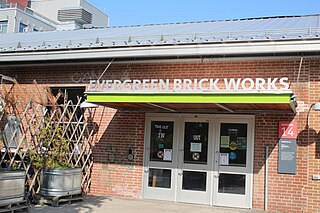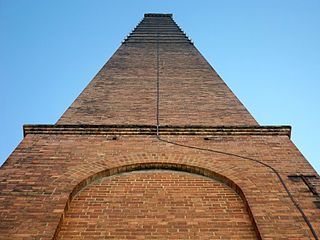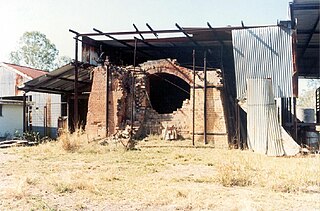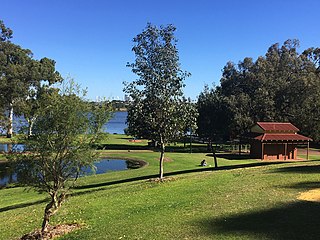
The Don Valley Brick Works is a former quarry and industrial site located in the Don River Valley in Toronto, Ontario, Canada. The Don Valley Brick Works operated for nearly 100 years and provided bricks used to construct many well-known Toronto landmarks, such as Casa Loma, Osgoode Hall, Massey Hall, and the Ontario Legislature. Since the closure of the original factory, the quarry has been converted into a city park which includes a series of naturalized ponds, while the buildings have been restored and opened as an environmentally focused community and cultural centre by Evergreen, a national charity dedicated to restoring nature in urban environments.

The City of Bayswater is a local government area in the Western Australian capital city of Perth, about 7 kilometres (4 mi) northeast of Perth's central business district. The city covers an area of 34.6 square kilometres (13.4 sq mi) and had a population of 69,283 as at the 2021 Census. The City of Bayswater is a member of the Eastern Metropolitan Regional Council.

Yarralumla is a large inner south suburb of Canberra, the capital city of Australia. Located approximately 3.5 km (2.2 mi) south-west of the city, Yarralumla extends along the south-west bank of Lake Burley Griffin from Scrivener Dam to Commonwealth Avenue.

Maylands is a riverside inner-city suburb approximately 4.5 kilometres (2.8 mi) northeast of Perth centred on the Midland and High Wycombe railway lines on the northern bank of the Swan River.

Maylands railway station is a suburban rail station in Maylands, a suburb of Perth, Western Australia. It is on the Midland and Airport lines, between Mount Lawley station and Meltham station. Maylands stationis 4.5 kilometres (2.8 mi), or eight minutes by train, from Perth station. Services on each line run every 12 minutes during peak and every 15 minutes between peak for a combined frequency of a train every 6 minutes during peak and every 7.5 minutes outside peak.

The Division of Perth is an Australian electoral division in the state of Western Australia. It is named after Perth, the capital city of Western Australia, where the Division is located.

A brickworks, also known as a brick factory, is a factory for the manufacturing of bricks, from clay or shale. Usually a brickworks is located on a clay bedrock, often with a quarry for clay on site. In earlier times bricks were made at brickfields, which would be returned to agricultural use after the clay layer was exhausted.

Sydney Park is a 41.6-hectare (103-acre) recreational area in the inner-city area of Sydney, New South Wales, Australia. The parkland is located in the suburb of Alexandria, sitting along the borders with Newtown and Erskineville.

Bayswater is a suburb 6 kilometres (4 mi) north-east of the central business district (CBD) of Perth, the capital of Western Australia. It is just north of the Swan River, within the City of Bayswater local government area. It is predominantly a low-density residential suburb consisting of single-family detached homes. However, there are several clusters of commercial buildings, most notably in the suburb's town centre, around the intersection of Whatley Crescent and King William Street and a light industrial area in the suburb's east.

The Hoffmann kiln is a series of batch process kilns. Hoffmann kilns are the most common kiln used in production of bricks and some other ceramic products. Patented by German Friedrich Hoffmann for brickmaking in 1858, it was later used for lime-burning, and was known as the Hoffmann continuous kiln.

Wesley Church is a Uniting Church in Perth, Western Australia, located at the corner of William Street and Hay Street. It is one of the oldest church buildings and one of few remaining 19th-century colonial buildings in the City of Perth.
Brickworks is Australia's largest brick manufacturer, consisting of four divisions – Building Products Australia, Building Products North America, Industrial Property, and Investments.
J. Hallett and Son, founded in 1904, was for most of the 20th century South Australia's most important brickmaking firm. Founded by Job H. Hallett in 1889, his son Thomas Hallett became a partner in 1904. There were several sites across Adelaide's western suburbs, with Halletts retaining their identity until the 1960s, when the company was absorbed by the Nubrik Hallett group.

The Clackline Refractory, also known as Clackline Clay and Brick, is a heritage listed brickworks site in Clackline, Western Australia.

Newmarket Brickworks Chimney is a heritage-listed brickworks at 117 Mina Parade, Alderley, City of Brisbane, Queensland, Australia. It was built in 1912. It is also known as Hoffman Stack. It was added to the Queensland Heritage Register on 24 March 2000.

Pindi Pindi Brickworks is a heritage-listed former brickworks off the Bruce Highway, Pindi Pindi, Mackay Region, Queensland, Australia. It was built in 1933. It is also known as Evans Firebricks Ltd and Pindi Pindi Firebricks Company. It was added to the Queensland Heritage Register on 27 October 2000.

The Brickworks Museum, also known as Bursledon Brickworks, is a volunteer-run museum in Swanwick, Hampshire, England. It is purportedly the UK's sole surviving Victorian steam-driven brickworks.

Bardon Park is a park overlooking the Swan River in Maylands, suburb of Perth, Western Australia. It is considered one of Perth's most picturesque parks.

The Lithgow Valley Colliery and Pottery Site is a heritage-listed former pottery and colliery and now pottery and visitor attraction at Bent Street, Lithgow, City of Lithgow, New South Wales, Australia. It was built from 1876 to 1945. It is also known as Lithgow Pottery and Brickworks. The property is privately owned. It was added to the New South Wales State Heritage Register on 2 April 1999.

The Peninsula Hotel is a heritage-listed former hotel in Maylands, Western Australia. Located at 221 Railway Parade, opposite Maylands railway station, it was constructed c. 1906 by owner Friederich Liebe. The historic Edwardian-style hotel was saved from demolition in the 1970s, becoming a space for several community groups, and later a Dôme cafe.



















